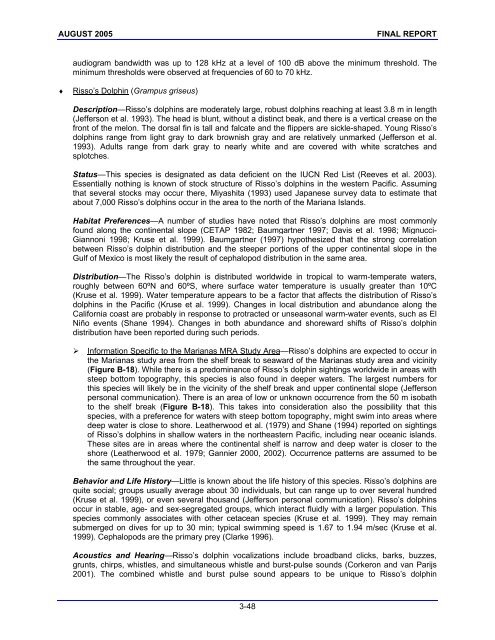Marine Resources Assessment for the Marianas Operating ... - SPREP
Marine Resources Assessment for the Marianas Operating ... - SPREP
Marine Resources Assessment for the Marianas Operating ... - SPREP
Create successful ePaper yourself
Turn your PDF publications into a flip-book with our unique Google optimized e-Paper software.
AUGUST 2005 FINAL REPORT<br />
audiogram bandwidth was up to 128 kHz at a level of 100 dB above <strong>the</strong> minimum threshold. The<br />
minimum thresholds were observed at frequencies of 60 to 70 kHz.<br />
♦ Risso’s Dolphin (Grampus griseus)<br />
Description—Risso’s dolphins are moderately large, robust dolphins reaching at least 3.8 m in length<br />
(Jefferson et al. 1993). The head is blunt, without a distinct beak, and <strong>the</strong>re is a vertical crease on <strong>the</strong><br />
front of <strong>the</strong> melon. The dorsal fin is tall and falcate and <strong>the</strong> flippers are sickle-shaped. Young Risso’s<br />
dolphins range from light gray to dark brownish gray and are relatively unmarked (Jefferson et al.<br />
1993). Adults range from dark gray to nearly white and are covered with white scratches and<br />
splotches.<br />
Status—This species is designated as data deficient on <strong>the</strong> IUCN Red List (Reeves et al. 2003).<br />
Essentially nothing is known of stock structure of Risso’s dolphins in <strong>the</strong> western Pacific. Assuming<br />
that several stocks may occur <strong>the</strong>re, Miyashita (1993) used Japanese survey data to estimate that<br />
about 7,000 Risso’s dolphins occur in <strong>the</strong> area to <strong>the</strong> north of <strong>the</strong> Mariana Islands.<br />
Habitat Preferences—A number of studies have noted that Risso’s dolphins are most commonly<br />
found along <strong>the</strong> continental slope (CETAP 1982; Baumgartner 1997; Davis et al. 1998; Mignucci-<br />
Giannoni 1998; Kruse et al. 1999). Baumgartner (1997) hypo<strong>the</strong>sized that <strong>the</strong> strong correlation<br />
between Risso’s dolphin distribution and <strong>the</strong> steeper portions of <strong>the</strong> upper continental slope in <strong>the</strong><br />
Gulf of Mexico is most likely <strong>the</strong> result of cephalopod distribution in <strong>the</strong> same area.<br />
Distribution—The Risso’s dolphin is distributed worldwide in tropical to warm-temperate waters,<br />
roughly between 60ºN and 60ºS, where surface water temperature is usually greater than 10ºC<br />
(Kruse et al. 1999). Water temperature appears to be a factor that affects <strong>the</strong> distribution of Risso’s<br />
dolphins in <strong>the</strong> Pacific (Kruse et al. 1999). Changes in local distribution and abundance along <strong>the</strong><br />
Cali<strong>for</strong>nia coast are probably in response to protracted or unseasonal warm-water events, such as El<br />
Niño events (Shane 1994). Changes in both abundance and shoreward shifts of Risso’s dolphin<br />
distribution have been reported during such periods.<br />
In<strong>for</strong>mation Specific to <strong>the</strong> <strong>Marianas</strong> MRA Study Area—Risso’s dolphins are expected to occur in<br />
<strong>the</strong> <strong>Marianas</strong> study area from <strong>the</strong> shelf break to seaward of <strong>the</strong> <strong>Marianas</strong> study area and vicinity<br />
(Figure B-18). While <strong>the</strong>re is a predominance of Risso’s dolphin sightings worldwide in areas with<br />
steep bottom topography, this species is also found in deeper waters. The largest numbers <strong>for</strong><br />
this species will likely be in <strong>the</strong> vicinity of <strong>the</strong> shelf break and upper continental slope (Jefferson<br />
personal communication). There is an area of low or unknown occurrence from <strong>the</strong> 50 m isobath<br />
to <strong>the</strong> shelf break (Figure B-18). This takes into consideration also <strong>the</strong> possibility that this<br />
species, with a preference <strong>for</strong> waters with steep bottom topography, might swim into areas where<br />
deep water is close to shore. Lea<strong>the</strong>rwood et al. (1979) and Shane (1994) reported on sightings<br />
of Risso’s dolphins in shallow waters in <strong>the</strong> nor<strong>the</strong>astern Pacific, including near oceanic islands.<br />
These sites are in areas where <strong>the</strong> continental shelf is narrow and deep water is closer to <strong>the</strong><br />
shore (Lea<strong>the</strong>rwood et al. 1979; Gannier 2000, 2002). Occurrence patterns are assumed to be<br />
<strong>the</strong> same throughout <strong>the</strong> year.<br />
Behavior and Life History—Little is known about <strong>the</strong> life history of this species. Risso’s dolphins are<br />
quite social; groups usually average about 30 individuals, but can range up to over several hundred<br />
(Kruse et al. 1999), or even several thousand (Jefferson personal communication). Risso’s dolphins<br />
occur in stable, age- and sex-segregated groups, which interact fluidly with a larger population. This<br />
species commonly associates with o<strong>the</strong>r cetacean species (Kruse et al. 1999). They may remain<br />
submerged on dives <strong>for</strong> up to 30 min; typical swimming speed is 1.67 to 1.94 m/sec (Kruse et al.<br />
1999). Cephalopods are <strong>the</strong> primary prey (Clarke 1996).<br />
Acoustics and Hearing—Risso’s dolphin vocalizations include broadband clicks, barks, buzzes,<br />
grunts, chirps, whistles, and simultaneous whistle and burst-pulse sounds (Corkeron and van Parijs<br />
2001). The combined whistle and burst pulse sound appears to be unique to Risso’s dolphin<br />
3-48
















